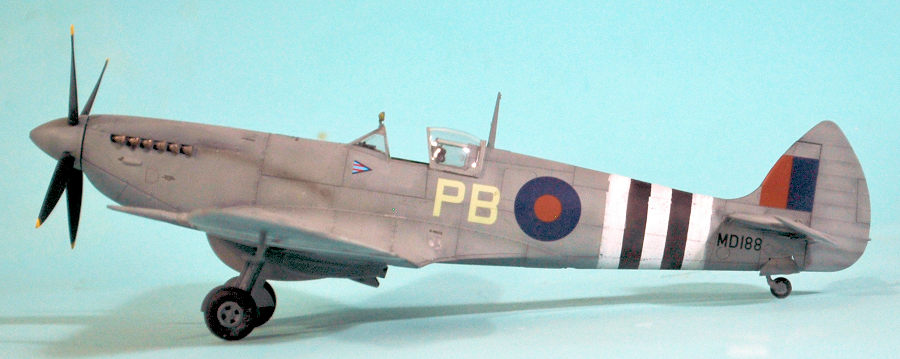
| KIT #: | |
| PRICE: | $ |
| DECALS: | Victory Productions Decals “Spitfire: Aces of the Empire” |
| REVIEWER: | Tom Cleaver |
| NOTES: | Overtrees Spit VIII/IX kits |

| HISTORY |
Designed to fulfill the high altitude fighter role, the Spitfire VII featured a pressurized cabin, extended span wings intially and a two speed, two stage intercooled Merlin engine. The engines fitted were intially the Merlin 61 with later production aircraft fitted with the Merlin 64, 70 or 71. New production aircraft were delivered with Merlin 64 engines beginning in February 1943, this engine being the most common engine fitted to Spitfire VIIs. The Merlin 64 was similar to the Merlin 63, with cabin supercharger and S.U. carburettor.
The Spitfire VII was the first production Spitfire to incorporate a retractable tail wheel. The aircraft was fitted with 12¾ gallon fuel tanks in the leading edge of each wing and 96 gallons in the main fuselage fuel tanks. It was also capable of carrying 30, 45, 90 or 170 gallon auxiliary belly tanks. Armament consisted of two 20 mm cannon and four .303 machine guns. 141 Spitfire VIIs were built.
 The first production
Spitfire VII was delivered to the RAF on 5 September 1942. The type followed the
Spitfire IX into service by two months and was similar in performace, being
equipped with the same Merlin 61 engine intially. The first RAF unit to operate
the Spitfire VII was the Special Service (High Altitude) Flight at Northolt.
The first production
Spitfire VII was delivered to the RAF on 5 September 1942. The type followed the
Spitfire IX into service by two months and was similar in performace, being
equipped with the same Merlin 61 engine intially. The first RAF unit to operate
the Spitfire VII was the Special Service (High Altitude) Flight at Northolt.
124 Squadron recorded in its Operations Record Book for 20 January 1943: “Six pilots and aircraft, of the S.S. Flight, of Northolt, who had been trained in special high altitude flying duties for interception of Sub stratosphere Ju 86s etc, arrived at North Weald, on the absorbtion of the flight by the Squadron. They brought with them a Spitfire VI, besides IXs and some of the new VIIs, with which the Squadron will be re-equipped.
“This type continues the pressure cabin of the old VI, but has a Merlin 61 engine, and a retractable tailwheel, which should give us the speed of any contemporary fighter. The Squadron looks forward to being re-equipped, and once again returning to the fore front of operations, besides being able to cope with any odd Ju86s.”
It would be March of 1943, however, before 124 Squadron transitioned to the Sptifire VII at North Weald and began using it on defensive operations. The first confirmed kill for a Spitfire VII occured on 15 May 1943 when F/O Oliver Willis shot down a reconnaissance Bf 109G-4, Werk No. 14906, of 4.(F)/123 flown by Lt. Wilhelm Marcks, who was killed. Willis mis-dentified the enemy aircraft thinking he had shot down an Fw 190. He recorded in his Combat Report:
“I was scrambled to intercept two bandits reported heading for Start Point at 1235 hrs. 15 May/43. At 1310 hours, when approximately 60 miles S.W. of Start Point, I opened fire on one of the e/a from astern at 400 yds range, seeing strikes on the fuselage and wing roots. The enemy aircaft was then lost from view, but I turned to re-engage and saw a parachute open and pieces of aircraft falling down to the sea. I claim this e/a as one Fw 190 destroyed.”
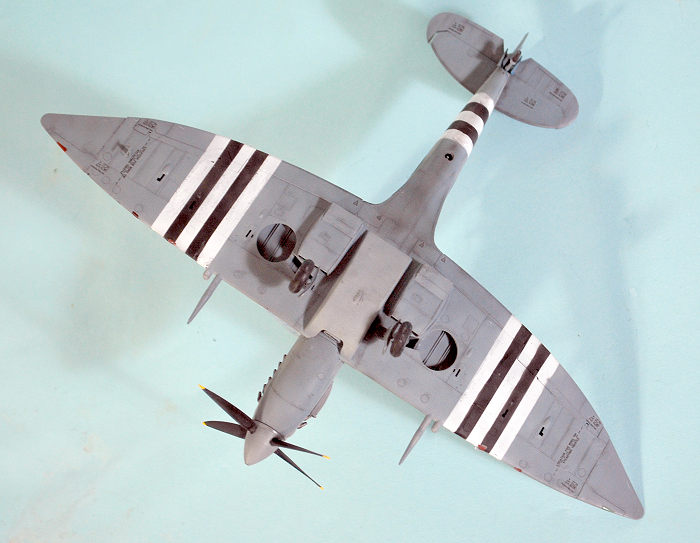 Additional
reconnaissance Bf 109s of Aufklärungsgruppe 123 were shot down by 124 Squadron
Spitfire VIIs during the summer of 1943. W/O Gareth Nowell shot down Bf 109G-4,
Werk No. 14910, of 5.(F) 123 over the English Channel on 13 June 1943, Fw. Heinz
Sieker missing in action. W/O Nowell scored again on 27 June 1943 shooting down
Bf 109G-4, Werk No. 14774, of 5.(F) 123, Uffz. Karl Beultzingslöwen missing in
action. F/O Basil Brooks shot down Bf 109G-4/R-3, Werk No. 14763, of 4.(F) 123
off the Isle of Wight on 16 August 1943, Ltn. Hans Jaschinski killed in action.
Additional
reconnaissance Bf 109s of Aufklärungsgruppe 123 were shot down by 124 Squadron
Spitfire VIIs during the summer of 1943. W/O Gareth Nowell shot down Bf 109G-4,
Werk No. 14910, of 5.(F) 123 over the English Channel on 13 June 1943, Fw. Heinz
Sieker missing in action. W/O Nowell scored again on 27 June 1943 shooting down
Bf 109G-4, Werk No. 14774, of 5.(F) 123, Uffz. Karl Beultzingslöwen missing in
action. F/O Basil Brooks shot down Bf 109G-4/R-3, Werk No. 14763, of 4.(F) 123
off the Isle of Wight on 16 August 1943, Ltn. Hans Jaschinski killed in action.
By September 1943 124 Squadron had added bomber escort missions to France in addition to thier usual scrambles and defensive patrols. F/O Paul Philipps destroyed another Me 109 over the Isle of Wight on 9 September 1943. 124 also accounted for a couple of Fw 190s destroyed in October with F/Sgts Kelly and Yeardly scoring over the Channel.
616 Squadron was the second squadron to convert to the Spitfire VII, doing so at Ibsley in September 1943. 616 continued to perform high altitude duties, just as they had with thier Spitfire VIs that preceeded the Spitfire VIIs. By October 1943, however, the squadron joined 124 Squadron in carrying out high cover escort of Mitchell bombers attacking airfields in France. Ramrods, scrambles patrols and defensive interceptions continued to be the principal tasks for the Spitfire VII squadrons into 1944.
131 Squadron began converting to Spitfire VIIs in February 1944 at Castletown and were fully converted and operational the following month. The squadron spent the spring flying Ramrods, Rodeos, Rhubarbs, Roadsteads as well as defensive scrambles and patrols. F/O Don Nicholson, of 131 Squadron, described his impressions of the Spitfire VII:
“The Mk VII was designed for high-altitude operations and our planes wore high-altitude camouflage, light grey on top and blue-grey underneath. I liked the VII, it was a good aeroplane. The hightest I ever took one was to 39,000 ft; it could have continued climbimg, but I had no reason to go any higher.”
In May the squadron had joined the Culmhead Wing with 616 Squadron, also flying Spitifre VIIs, and were largely operating over the Normandy area performing a wide assortment of missions. The Culmhead Wing had a good day on 12 June 1944 when they destroyed six enemy aircraft (probably from JG 11 and JG 27) during Rodeo 169 to Le Mans and Laval airfields. Also on the 12th, a section from 124 Squadron flying out of Bradwell Bay downed a Bf 109 into the sea 20 miles east of Dover. It is difficult to know with certainty who the victims were of the Spitfire VIIs on this date. The Luftwaffe had been hit hard, losing 19 Fw 190s and 26 Bf 109s in the invasion area, JG 27 alone suffering 17 BF 109 G-6s shot down. 131 Squadron met with futher success with two Fw 190s shot down on 6 August near Argentan and Le Mans followed by three Fw 190s shot down the following day along the valley of the River Loire. W/C Peter Brothers described the action from 7 August 1944 while leading 131 Squadron:
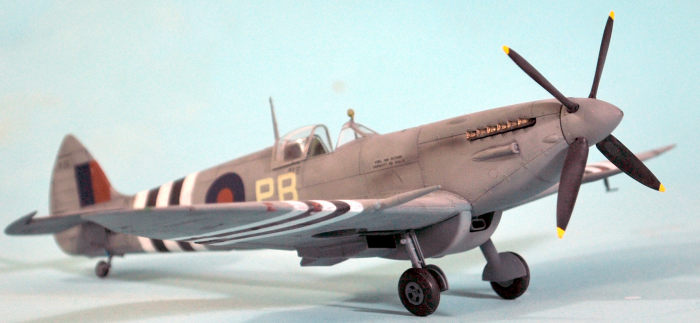 “Approaching Bourges we
saw in the distance two Me109s which we chased briefly but failed to catch them
so gave up as they were drawing us far off our route. Our action was to be
rewarded however, for nearing Blois we ran into fifteen FW190s which dived away
with us in hot pursuit. Sammy and I chased a pair which separated, mine to the
left, his to the right. By now down to ground level, as I closed the range I was
surprised to see my 190 start a gentle climb and weave equally gently to left
and right, offering a perfect target. 'Oh, my god, you poor sucker. You must be
straight out of training school,' I thought. It seemed so unfair and spoilt the
exhilaration of the chase. This was not to be an exciting duel but a massacre.
Worse was to follow.
“Approaching Bourges we
saw in the distance two Me109s which we chased briefly but failed to catch them
so gave up as they were drawing us far off our route. Our action was to be
rewarded however, for nearing Blois we ran into fifteen FW190s which dived away
with us in hot pursuit. Sammy and I chased a pair which separated, mine to the
left, his to the right. By now down to ground level, as I closed the range I was
surprised to see my 190 start a gentle climb and weave equally gently to left
and right, offering a perfect target. 'Oh, my god, you poor sucker. You must be
straight out of training school,' I thought. It seemed so unfair and spoilt the
exhilaration of the chase. This was not to be an exciting duel but a massacre.
Worse was to follow.
“I think I am not alone in regarding air combat as tremendously stimulating fun as one shoots in an attempt to knock down an aircraft. There is nothing personal in it and one is usually spared the thought of bodily injury. It can be wholly impersonal, unless one had the misfortune to have suffered like the Poles, Czechs and others who left loved ones behind in the hands of a brutal enemy. I opened fire and was horrified and sickened to see my cannon shells not knock off a wing or tail of the aircraft, but blast straight into the cockpit instantly killing the pilot. The aircraft flipped over and hit the ground. 'I am sorry, I didn’t mean that,' I said out loud. Then I thought at least it was quick – and you chaps nearly killed my wife in 1940.
“My thoughts came back to reality as I answered a radio call from 'Closet' Waterhouse, one of the flight commanders who had shot down another FW190. Gathering together as many of the squadron as were not too widely scattered by the combat, I set course for Vire and home. It had been another good day.”
124 Squadron flew thier last operationl mission using Spitfire VIIs on 18 July 1944, an escort to Lancasters and Halifaxes bombing Caen, after which they went over exclusively to Spitfire HF IXs. 616 Squadron began transitioning to Meteors in July 1944 and by August had ceased operations with Spitfire VIIs, although they kept a few VIIs on charge through 1944 for non operational duties. At the end of October 1944 131 Squadron was withdrawn from operations in preparation for deployment to the Far East and all of it's Spitfire VIIs allocated to 154 Squadron, who flew the type on bomber escort operations out of Biggin Hill into February 1945, when they converted to Mustangs. A number of Spitfire VIIs were also used by RAF meteorological units, namely 1402 Flight and Nos. 518 and 519 Squadrons from Autumn 1944 to December 1945.
| CONSTRUCTION |
This conversion is easy - assuming you have a few Eduard Spitfire kits available. I used an Eduard Spitfire VIII weekend kit, and a Spitfire Ixc (early) Overtrees. You also need a flat-top canopy from a Spitfire I/II/V kit (the ones with all the extra clear parts on the sprue)
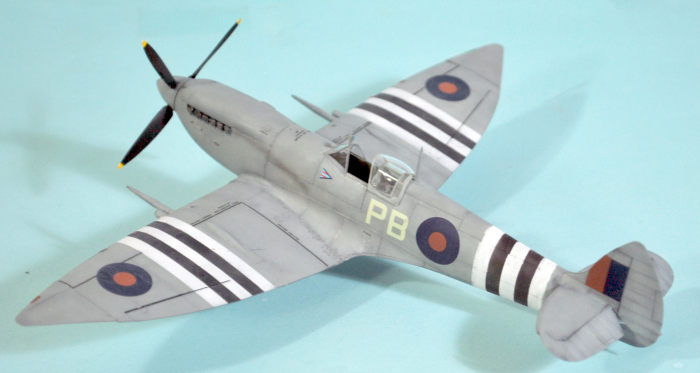 To do this conversion,
use the Spitfire VIII as the primary kit. You need to modify the fuselage halves
by cutting down the area of the rear clear glass, to the same level as the
canopy glass, since the Spitfire VII differed in this area. Also, glue the
sideflap closed. Glue the sideflap closed, fill the forward joint and sand
smooth.
To do this conversion,
use the Spitfire VIII as the primary kit. You need to modify the fuselage halves
by cutting down the area of the rear clear glass, to the same level as the
canopy glass, since the Spitfire VII differed in this area. Also, glue the
sideflap closed. Glue the sideflap closed, fill the forward joint and sand
smooth.
Assemble the Spitfire VIII kit per instructions, except you should substitute the lower wing part from the Spitfire Ixc kit and the smaller carburettor intake parts. Depending on whether you are doing a Spitfire VII in original configuration (with extended tips) or as it was soon modified in the summer of 1944 to the standard configuration (with standard tips), attach the proper wingtips.
Take the flat-top canopy and cut it to fit the rear area fore and aft. You may find that you have a little bit of the clear air port visible. You can either sand that down smooth and polish the part, or leave it alone, since if you attach the part so that is forward, it will be under the sliding canopy and not very noticeable. When you have what you want, attach it.
I used the large slipper tank from the Eduard Spitfire Vc kit after finding a photo of its used by the wing. It makes sense since they were flying from Cornwall to Normandy.
| COLORS & MARKINGS |
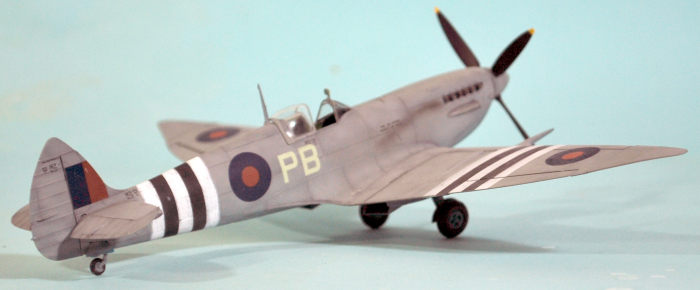 The Spitfire VII was
painted in the “high altitude” scheme of PRU Blue undersides and Medium Sea Grey
uppers. 12 Group Spitfires used non-standard 12-inch “D-Day” ID stripes, rather
than the standard 18-inch stripes.
The Spitfire VII was
painted in the “high altitude” scheme of PRU Blue undersides and Medium Sea Grey
uppers. 12 Group Spitfires used non-standard 12-inch “D-Day” ID stripes, rather
than the standard 18-inch stripes.
I painted and masked the white D-Day stripes, then preshaded the model with Flat Black. I then masked the black D-Day stripes. I used Xtracolor PRU Blue for the lower color, and Tamiya XF-83 Sea Grey Medium for the upper colors.
I used the Victory Productions Decals sheet for the personal markings and serial to do Wing commander Pete Brothers’ Spitfire VII. I used the kit decals for the stencils and the fin flash, and Type B roundels from Xtradecal.
I unmasked the canopy, attached the landing gear and prop, and called the project completed.
| CONCLUSIONS |
It’s highly unlikely Eduard will ever do a Spitfire VI or VII, but the conversion effort to create each is not that hard, mostly a job of “mix and match”. As to that leftover Spitfire IXc early kit with the missing lower wing part, I intend to use the kit with the lower wing from the Spitfire VIII kit, transfer the upper wing with the molded-in large cannon bulges with a Spitfire Vc kit, and match the upper wing from that kit with a narrow-bulge cannon cover to create a late production Spitfire IX. After all, there’s no such thing as too many Eduard Spitfires in the collection. This conversion can be done by any modeler with experience.
5 August 2022
Review kits courtesy of my wallet.
Copyright ModelingMadness.com. All rights reserved. No reproduction in part or in whole without express permission.
If you would like your product reviewed fairly and quickly, please contact the editor or see other details in the Note to Contributors.